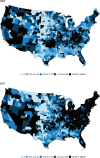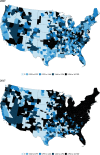Population-Based Opioid Prescribing and Overdose Deaths in the USA: an Observational Study
- PMID: 35657466
- PMCID: PMC9905341
- DOI: 10.1007/s11606-022-07686-z
Population-Based Opioid Prescribing and Overdose Deaths in the USA: an Observational Study
Abstract
Background: Rising opioid-related death rates have prompted reductions of opioid prescribing, yet limited data exist on population-level associations between opioid prescribing and opioid-related deaths.
Objective: To evaluate population-level associations between five opioid prescribing measures and opioid-related deaths.
Design: An ecological panel analysis was performed using linear regression models with year and commuting zone fixed effects.
Participants: People ≥10 years aggregated into 886 commuting zones, which are geographic regions collectively comprising the entire USA.
Main measures: Annual opioid prescriptions were measured with IQVIA Real World Longitudinal Prescription Data including 76.5% (2009) to 90.0% (2017) of US prescriptions. Prescription measures included opioid prescriptions per capita, percent of population with ≥1 opioid prescription, percent with high-dose prescription, percent with long-term prescription, and percent with opioid prescriptions from ≥3 prescribers. Outcomes were age- and sex-standardized associations of change in opioid prescriptions with change in deaths involving any opioids, synthetics other than methadone, heroin but not synthetics or methadone, and prescription opioids, but not other opioids.
Key results: Change in total regional opioid-related deaths was positively correlated with change in regional opioid prescriptions per capita (β=.110, p<.001), percent with ≥1 opioid prescription (β=.100, p=.001), and percent with high-dose prescription (β=.081, p<.001). Change in total regional deaths involving prescription opioids was positively correlated with change in all five opioid prescribing measures. Conversely, change in total regional deaths involving synthetic opioids was negatively correlated with change in percent with long-term opioid prescriptions and percent with ≥3 prescribers, but not for persons ≥45 years. Change in total regional deaths in heroin was not associated with change in any prescription measure.
Conclusions: Regional decreases in opioid prescriptions were associated with declines in overdose deaths involving prescription opioids, but were also associated with increases in deaths involving synthetic opioids (primarily fentanyl). Individual-level inferences are limited by the ecological nature of the analysis.
© 2022. The Author(s), under exclusive licence to Society of General Internal Medicine.
Conflict of interest statement
The authors declare that they do not have a conflict of interest.
Figures
Similar articles
-
Opioid Prescribing and Suicide Risk in the United States.Am J Psychiatry. 2023 Jun 1;180(6):418-425. doi: 10.1176/appi.ajp.22020102. Epub 2023 Apr 11. Am J Psychiatry. 2023. PMID: 37038742
-
Controlled Substance Prescribing Patterns--Prescription Behavior Surveillance System, Eight States, 2013.MMWR Surveill Summ. 2015 Oct 16;64(9):1-14. doi: 10.15585/mmwr.ss6409a1. MMWR Surveill Summ. 2015. PMID: 26469747
-
Overdose deaths from nonprescribed prescription opioids, heroin, and other synthetic opioids in Medicare beneficiaries.J Subst Abuse Treat. 2021 May;124:108282. doi: 10.1016/j.jsat.2021.108282. Epub 2021 Jan 7. J Subst Abuse Treat. 2021. PMID: 33771281 Free PMC article.
-
Fourth Wave of Opioid (Illicit Drug) Overdose Deaths and Diminishing Access to Prescription Opioids and Interventional Techniques: Cause and Effect.Pain Physician. 2022 Mar;25(2):97-124. Pain Physician. 2022. PMID: 35322965 Review.
-
Tramadol Prescription over a 4-Year Period in the USA.Curr Pain Headache Rep. 2019 Aug 6;23(10):76. doi: 10.1007/s11916-019-0777-x. Curr Pain Headache Rep. 2019. PMID: 31388761 Review.
Cited by
-
Opioid-related mortality after occupational injury in Washington State: accounting for preinjury opioid use.Occup Environ Med. 2024 Oct 23;81(10):515-521. doi: 10.1136/oemed-2024-109606. Occup Environ Med. 2024. PMID: 39327042
-
Deimplementation in the provision of opioid agonist treatment to achieve equity of care for people engaged in treatment: a qualitative study.Implement Sci. 2023 Jun 9;18(1):22. doi: 10.1186/s13012-023-01281-4. Implement Sci. 2023. PMID: 37296448 Free PMC article.
-
Peripheral Nerve Stimulation in Painful Conditions of the Upper Extremity-An Overview.Biomedicines. 2022 Nov 1;10(11):2776. doi: 10.3390/biomedicines10112776. Biomedicines. 2022. PMID: 36359295 Free PMC article. Review.
-
An Exploratory Analysis of Differential Prescribing of High-Risk Opioids by Insurance Type Among Patients Seen by the Same Clinician.J Gen Intern Med. 2023 May;38(7):1681-1688. doi: 10.1007/s11606-023-08025-6. Epub 2023 Feb 6. J Gen Intern Med. 2023. PMID: 36745303 Free PMC article.
References
-
- National Institute on Drug Abuse, Overdose death rates. https://www.drugabuse.gov/drug-topics/trends-statistics/overdose-death-r...
-
- Dowell D, Haegerich TM, Chou R. CDC guideline for prescribing opioids for chronic pain—United States, 2016. MMWR Recomm Rep. 2016;65(1):1–49. - PubMed
Publication types
MeSH terms
Substances
Grants and funding
LinkOut - more resources
Full Text Sources



